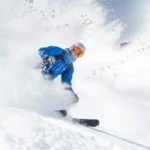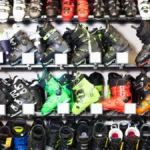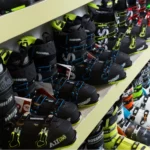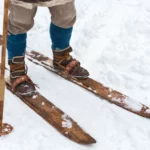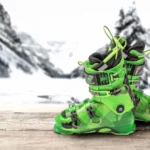Ski Boot Pain and Discomfort: 5 Common Causes

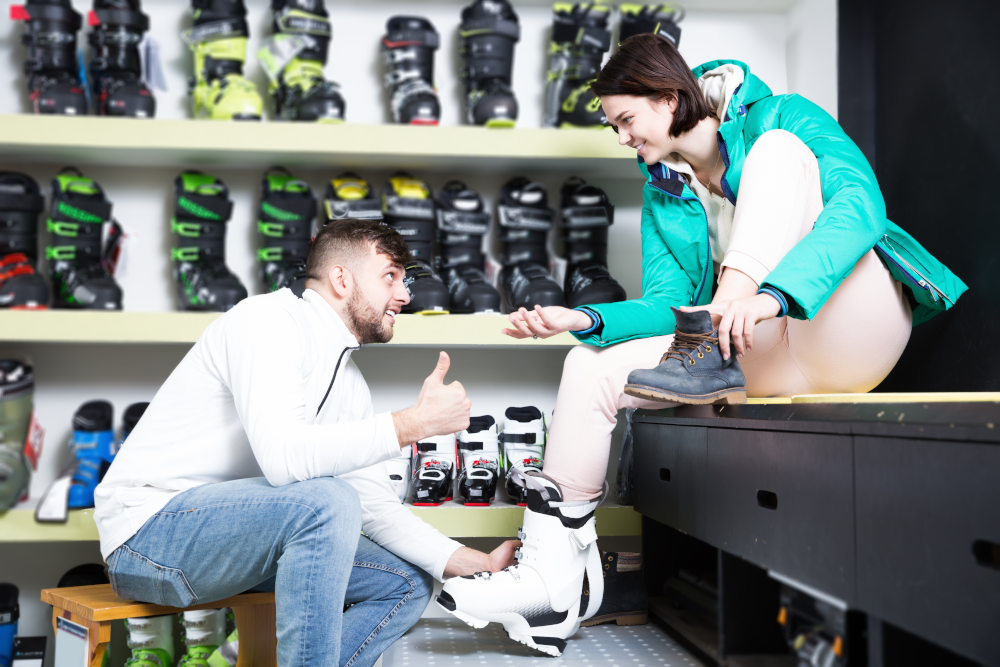
Not many things can ruin a beautiful day on a ski mountain like sore feet. Discomfort caused by your ski boot will certainly push you to stop skiing for the day but could lead to an even longer break from the slopes. Let’s review the common causes of ski boot pain, and what can be done about them.
Commons Causes of ski boot pain
Ski boots are the least forgiving footwear given the job they have to do, but a good-fitting ski boot should not cause any pain, pinching, or pressure. The goal of the ski boot is to provide comfort and performance at the same time. In addition to the right ski socks, there are four key aspects of a ski boot that determine if the day on the slopes will be one of all-day comfort and warmth or pain and cold feet.
Wrong Size
One of the most common issues that will cause ski boot pain and discomfort is not picking the right size ski boot. It can be tempting to go a size bigger so that the ski boot feels more comfortable. However, that can lead to all sorts of issues – mainly the inability to control the skis, not to mention the foot banging inside the boot. On the other hand, going for too small of a boot and trying to achieve a snug fit will also lead to pain and discomfort.
Bad Fit
Once you have the right size ski boot, you should focus on ensuring a good fit. A ski boot fit can be broken down into fits in five areas of the ski boot.
Toes and the front of the ski boot
The ski boot and liner should fit well around the toes and front of the foot. If your toes feel cramped or you experience numbness, it’s a sign that the fit isn’t right. On the other hand, if the toes are not touching the front of the liner, your foot could slide and your toes can bang into the front during aggressive skiing, and you’ll also have a hard time controlling your skis.
Make sure there’s just enough room for your toes to lightly touch the front of the boot when standing, and the liner should comfortably contour to the shape of your foot without being overly tight.
Width of the foot and ski boot
The width of a ski boot is crucial for comfort and can cause pain if not fitted correctly. Symptoms of a poor width fit include pinching or pressure on the sides of your feet, leading to discomfort or even numbness. It’s important to choose ski boots that match the width of your feet, offering snug support without squeezing or allowing too much movement inside the boot.
Instep area
If the instep area of the ski boot is too tight, you’ll likely feel uncomfortable or painful pressure across the top of your foot. This issue often occurs when the boot’s instep area is too low or narrow for the natural arch of your foot. To prevent this, ensure your ski boots have enough room in the instep area to comfortably accommodate the arch of your foot, even in ski socks, without exerting excessive pressure. Sometimes a skiing-specific orthotic insert can help.
Heel and ankle
If your boots don’t fit well in this area, you might experience slipping or rubbing at the heel, leading to blisters. This usually happens with boots that are too loose or lack adequate support around the ankle and heel. To prevent this, choose ski boots that offer a snug fit around the heel and ankle, providing support without allowing the heel to lift or being too tight.
Calf area
If the boot is too tight around the calf, you might experience a feeling of constriction and discomfort, while a boot that’s too loose can lead to chafing and shin bang. It’s crucial to choose a boot with an adjustable calf area and the right volume, ensuring a comfortable, supportive fit regardless of whether your calves are slimmer or larger.
Wrong Flex
Ski boot flex refers to how much a ski boot bends forward under pressure, which is crucial for both control and comfort on the slopes. The right amount of flex is essential for effective skiing as it allows for precise control and power transfer to the skis. Too much or too little flex can negatively impact performance and comfort; a boot that’s too stiff may hinder movement, while one that’s too flexible can reduce control and stability, especially at higher speeds or on challenging terrain.
Choosing the right flex depends on your skiing level, weight, and height. Beginner skiers usually need a softer flex to make turning easier and to get comfortable with basic movements. Advanced skiers benefit from a stiffer flex for better control and precision at higher speeds. Your weight and height also play a role. Heavier or taller skiers might need a stiffer boot to support their weight and leverage, whereas lighter or shorter skiers can often use a softer flex for better maneuverability.
There is no standard flex rating, but typically beginner skiers will use a flex rating of less than 90, intermediate skiers between 90 and 110, and experts greater than 110. The stiffest ski boots are worn by racers, often having a flex rating of 130 or higher.
Buckles
It is best to buckle ski boots when they are warm. If they feel cold when you first put them on, wait a few minutes for the liner to be softer and achieve a better fit. For best results start buckling your ski boot from top to bottom by first tightening the buckles on your cuff and shin areas. Then, lean forward so that your shin touches the boot tongue, your toes slide back and your heel is securely placed in the heel pocket before buckling the bottom two buckles. This should create a comfortably snug fit, preventing the foot from sliding.
After a few ski runs, the liner may compress, requiring a readjustment of the buckles for optimal fit and comfort.
Socks
Another common issue that can cause discomfort in your ski boot is wearing the wrong socks. Ski socks should feel snug and thin, and they shouldn’t gather or chafe. You may feel the need to opt for thicker socks for warmth, but unless they are made specifically for skiing, socks tend to bunch up or make it difficult to achieve a snug, slip-free fit inside the ski boot.
Lastly, you might be tempted to tuck your base layer into your socks or the ski boot. This will create pressure points on your shins as you lean forward while skiing.
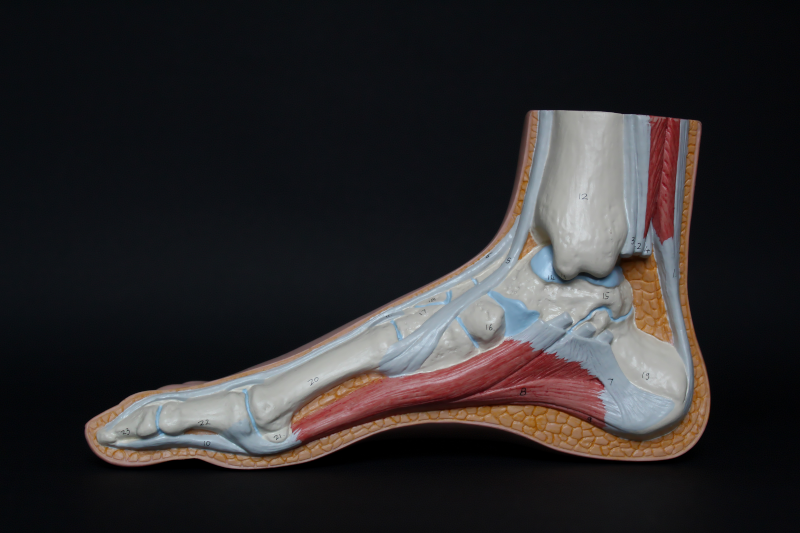
Common Ski boot pains and discomforts
Shin Bang
Shin bang is characterized by pain and tenderness on the shin caused by repeated contact between the shin and the ski boot tongue. This problem often arises from ski boots that aren’t properly fitting in the cuff area. To prevent shin bang, make sure your ski boots fit properly, and consider low-volume ski boots.
Toe Bang and Black Toenail
Toe bang is what skiers call the sharp pain in the toes that occurs when they repeatedly hit the front of the ski boot. Meanwhile, a black toenail is a bruised toenail caused by sustained pressure against the nail. These problems usually stem from wearing ski boots that are either too big or too tight. It can also be caused by aggressive skiing and jumping. To prevent injuries to your toes, pay attention to where your toes sit in the boot. They should only just touch the front liner.
Arch Pain
Arch pain is a persistent soreness or pain in the arch area that’s especially noticeable during or after skiing. This pain often comes from wearing ski boots that don’t properly support the foot’s arch. To prevent it, choose boots with good arch support that hug the foot well.
Ankle Pressure Points
Ankle pressure points are specific areas around the ankle where skiers often feel discomfort due to pressure from their ski boots. The symptoms usually include pain, soreness, or even numbness in these ankle areas, which can become more noticeable after skiing. This discomfort is typically caused by ski boots that are too tight or not adequately padded around the ankle. A professional boot fitter can help you ensure you have the correct fit in this area.
Instep Pain
Instep pain is felt as a sharp or aching pain on the top of the foot. This pain often results from ski boots that are too tight across the instep, applying excessive pressure on the top of the foot. To prevent this, make sure your ski boots provide enough room for your foot to sit comfortably when buckled. Or better yet, consider ski boots with adjustable instep buckles for a more customized fit.
Calf Pain
Calf pain is characterized by aching or soreness in the calf muscles. This type of pain usually results from ski boots that are too tight or improperly aligned around the calf, causing excessive strain on the muscles. High-volume ski boots with a proper fit around the calf can provide the optimal level of support while ensuring the correct alignment of the boot with your skiing stance will significantly reduce the risk of calf pain.
Heel Lift
Heel lift is when the heel rises inside the boot during skiing, which causes a feeling of instability or loss of control. This happens when your boots are too large or lack adequate heel support. Make sure your ski boots fit snugly, particularly around the heel, and consider using heel inserts or custom insoles for better stability.
Cold Feet
Skiers frequently encounter cold feet, where feet become uncomfortably cold while skiing. This chill or numbness in the feet can detract from the skiing experience. This problem isn’t caused by ineffective socks, but rather by overly tight ski boots or inadequate insulation. To prevent cold feet, ensure your boots fit well without being too constrictive, and check that your boot liners are not packed out, or consider replacing them.
Bone Spurs
Skiers who have bony growths known as bone spurs often feel extreme pain due to pressure and friction from ski boots. The symptoms include localized pain, swelling, and discomfort in the area of the bone spur. This issue is typically caused by wearing ski boots that don’t fit properly, leading to constant rubbing and pressure. To prevent aggravating bone spurs, make sure your ski boots fit correctly, particularly around known pressure points. A good boot fitter can make a big difference in finding the right fit.
Conclusion
There are numerous reasons why a ski boot can give you pain and discomfort. Knowing your skill level and physical needs, and focusing on the five key aspects mentioned above will go a long way in helping you address and prevent foot and leg comfort issues while spending a long day on the slopes in your ski boots.
Give your ski boots a proper fit test before buying them to minimize the chances of running into any of these common ski boot pain issues. To learn more about how to pick the right ski boot check out our ski boot buying guide.
